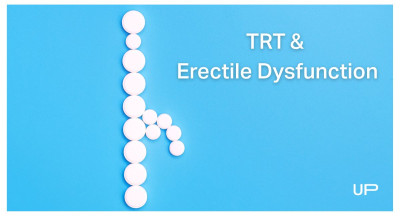TRT And Fertility: Can You Still Have Kids On Testosterone?


Thinking about testosterone replacement therapy (TRT) in Canada, but worried about your future ability to have children? You’re not alone.

Many men considering TRT have concerns about how it might affect their fertility, and for good reason.
While testosterone plays a key role in male reproductive health, taking TRT can impact your body’s natural hormone production and, in turn, your sperm count.
Before starting treatment, it’s important to understand how TRT works, what risks it may carry, and what steps you can take to protect your fertility if kids are in your future.
Topics covered in this article:
How TRT Affects Sperm Production
Testosterone replacement therapy (TRT) can have a significant effect on male fertility. While it helps boost energy, libido, and mood in men with low testosterone, it can also interfere with your body’s natural hormone system—especially the one responsible for sperm production.

Here’s how it works:
- TRT introduces external testosterone into the body, which signals the brain that enough testosterone is present.
- As a result, the pituitary gland reduces production of luteinizing hormone (LH) and follicle-stimulating hormone (FSH)—both essential for triggering sperm production in the testes.
- This drop in LH and FSH can lead to reduced or even zero sperm production, a condition called azoospermia.
- The effect can be temporary or long-lasting, depending on how long you’re on TRT and whether your body rebounds after stopping treatment.
For men trying to conceive, this suppression of natural sperm production is a key concern, and one that needs to be discussed with a doctor before starting TRT.
Is TRT Permanent? Can Fertility Recover?
The good news is that fertility suppression caused by testosterone replacement therapy (TRT) is often reversible—especially when addressed early and managed properly.
Key points to know:
- Most men can recover sperm production after stopping TRT, although recovery may take several months to over a year.
- Younger men and those on TRT for a shorter duration tend to recover faster.
- Fertility-focused treatments like hCG (human chorionic gonadotropin) or clomiphene citrate can help stimulate the body to restart natural testosterone and sperm production.
- Recovery is not guaranteed for everyone, especially after long-term use without medical oversight.
That’s why men in Canada considering testosterone replacement therapy (TRT in Canada) should talk openly with their doctor if they plan to have children now or in the future.
Options to Preserve Fertility Before Starting TRT
If you're thinking about testosterone replacement therapy (TRT) in Canada and hope to have children in the future, it’s smart to plan ahead. Some simple steps can help protect your fertility before starting treatment.
Common options include:
- Sperm banking: Also called cryopreservation, this involves freezing your sperm at a fertility clinic for future use. It’s a reliable and widely available option in Canada.
- Timing around family planning: If you’re actively trying to conceive, some men choose to delay TRT or explore fertility-preserving alternatives like clomiphene citrate or hCG under medical supervision.
These strategies give men the flexibility to manage low testosterone while keeping future parenthood on the table.

How Some Men Stay Fertile While on TRT
Although testosterone replacement therapy (TRT) in Canada can suppress sperm production, some men are able to maintain fertility with the help of additional medications and carefully managed treatment plans.
Common medical strategies include:
- hCG (human chorionic gonadotropin): This hormone mimics LH (luteinizing hormone), which signals the testes to keep producing sperm even during TRT. It’s often prescribed alongside testosterone to preserve fertility.
- Clomiphene citrate: A non-steroidal medication that boosts the body’s natural testosterone production while supporting sperm production. It’s sometimes used as an alternative to TRT or in combination with it.
- Modified TRT protocols: Some specialists use lower-dose or intermittent testosterone regimens combined with fertility-supportive medications to balance symptom relief with reproductive goals.
These options require close medical supervision, but they offer a way to manage low testosterone without sacrificing fertility.
Planning Parenthood After TRT
If you're planning to start a family after testosterone replacement therapy (TRT) in Canada, it’s important to understand the recovery timeline and what to expect.
Here’s what the process often involves:
- Recovery time: Sperm production may take several months to return after stopping TRT. For some men, it can take 6 to 12 months or longer, depending on how long they were on therapy and individual factors.
- Monitoring: Regular semen analyses can track recovery. Your doctor may also check hormone levels like FSH, LH, and testosterone to assess progress.
- Supportive therapies: Medications such as hCG or clomiphene citrate may be used during recovery to help restart natural testosterone and sperm production more quickly.
With proper planning and medical guidance, many men are able to father children after TRT.

Conclusion: Know the Risks, Plan Ahead, Stay Informed
Testosterone replacement therapy (TRT) in Canada can significantly improve the quality of life for men with low testosterone, but it’s important to understand how it may affect fertility. The good news is that infertility linked to TRT is often temporary and manageable. With proper planning, such as sperm banking or adjusted treatment protocols, many men go on to have children after or even during treatment. The key is to work with a knowledgeable healthcare provider and make informed decisions based on your personal goals. Don’t guess — get the facts, ask the right questions, and protect your future.
FAQs: TRT and Fertility
TRT can lower sperm production by suppressing natural testosterone and signals from the brain that control fertility. However, infertility is often reversible with proper treatment and medical oversight.
Some men can maintain fertility while on TRT by using medications like hCG or clomiphene citrate under medical supervision. These help preserve sperm production during therapy.
In most cases, no. Sperm counts typically recover after stopping TRT, though it may take several months. Recovery depends on how long you’ve been on therapy and your individual response.
Talk to your doctor about sperm banking before starting TRT. You may also be eligible for fertility-preserving protocols that combine TRT with supportive medications.
Fertility recovery can take 3 to 12 months or longer, depending on the individual. Your doctor may recommend follow-up testing or treatments to support sperm production during this period.
References
UPGUYS has strict sourcing guidelines to ensure our content is accurate and current. We rely on peer-reviewed studies, academic research institutions, and medical associations. We strive to use primary sources and refrain from using tertiary references.- Testosterone Is a Contraceptive and Should Not Be Used in Men Who Desire Fertility, PubMed,
https://pmc.ncbi.nlm.nih.gov/articles/PMC6305868/#:~:text=Exogenous%20testosterone%20comes%20in%20various,inhibits%20intra%2Dtesticular%20testosterone%20production. - Recovery of spermatogenesis following testosterone replacement therapy or anabolic-androgenic steroid use, PubMed,
https://pmc.ncbi.nlm.nih.gov/articles/PMC4854084/
This article is written for informational purposes only and does not constitute medical advice. The information provided in the articles cannot and should not replace advice from a healthcare professional. Talk to your healthcare provider about any physical or mental health concerns or the risks and benefits of any treatment or medication.





